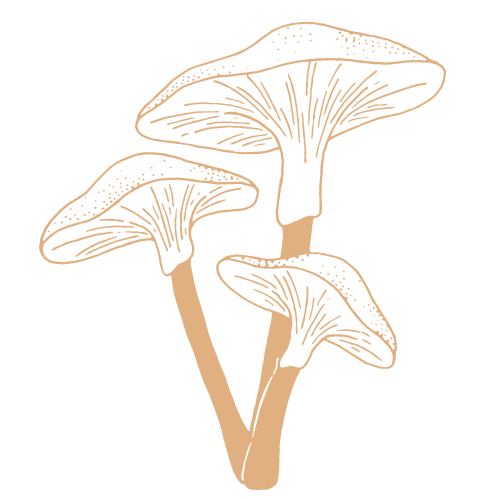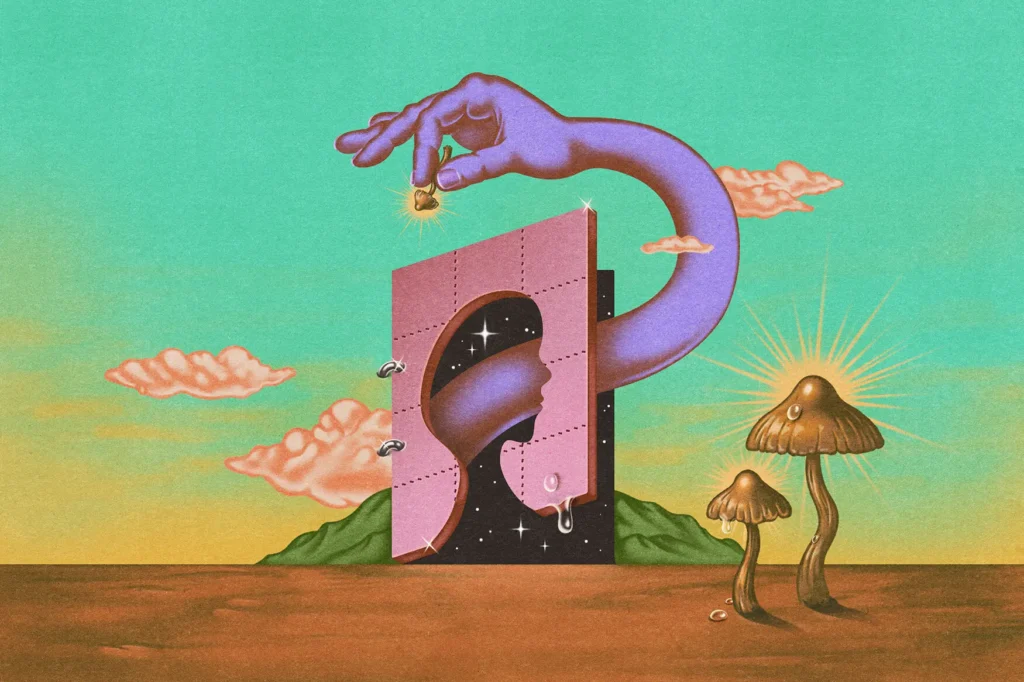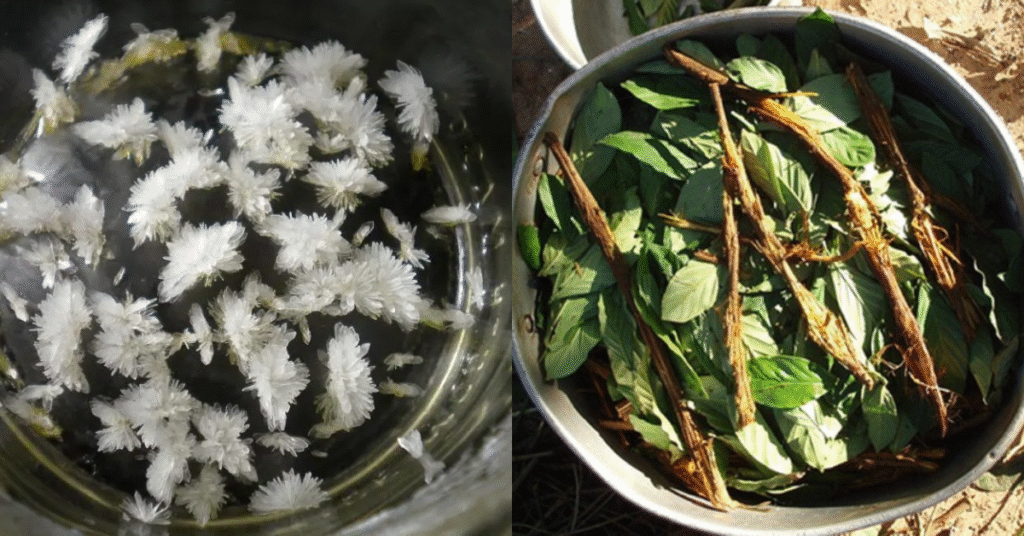In the quest for mental wellness, microdosing with psychedelics has emerged as a beacon of hope for many. This practice involves the administration of subperceptual doses of substances like LSD or psilocybin. Which are fractions of what one would consume for a full psychedelic experience. However, the idea is not to induce a ‘trip’ but to subtly enhance cognitive and emotional functions.
Microdosing with psychedelics may enhance mood, creativity, concentration, productivity, and empathy, but it is unclear if these benefits are due to the actual substances or simply the expectation of positive effects. However due to lack of proven science behind microdsoing, the side effects may vary depending on the individual. Before you microdose talk with your doctor about your decision of microdosing with psychedelic.
Microdosing with Psychedelics
Microdosing with psychedelics refers to the practice of taking very small, sub-perceptual doses of substances like LSD or psilocybin, which are known for their hallucinogenic effects at higher doses. The idea is that these microdoses can enhance mood, creativity, concentration, and productivity, without causing the intense experiences associated with full doses.
Microdosing definition
Microdosing is not a one-size-fits-all concept; it’s a personalized journey. Typically, a microdose ranges from 1/5 to 1/20 of a recreational dose. For psilocybin mushrooms, this translates to about 0.3 grams, considering a medium-strength dose is between 2 to 3 grams. However, due to the unregulated nature of these substances, precision in dosing remains a challenge.
Furthermore, the potency of mushrooms and LSD can vary greatly as they are not regulated, making it difficult to determine the exact dosage.
How much is a microdose?
Researchers generally consider a microdose to be about 1/10 or 1/20 of a normal recreational dose. For LSD, this would typically be a dose of about 5 μg to 20 μg. The psilocybin microdose range is typically 0.1 g to 0.3 g. The goal is to take enough to have potential benefits — but without causing someone to feel high or intoxicated.
How often should you Microdose with Psychedelics
To begin with, the frequency of microdosing can vary, but a common starting point is the “one day on/two days off” schedule. This means taking a microdose on one day, then having two days without dosing before repeating the cycle. This schedule allows for slight effects on the dose day, an afterglow on the next day, and no effects on the third day, ensuring that your receptors have time to clear before the next dose.
For instance, it’s important to note that there are different microdosing schedules. And individuals may need to adjust based on their response and preferences. Keeping a journal to track effects and adjusting the schedule accordingly can help find the right frequency for optimal results.
How long does a Microdose with Psychedelics last
The effects of a microdose with psychedelics like LSD or psilocybin mushrooms vary in duration. Typically, a person feels the subtle effects of a microdose for a few hours after taking it, and some report an ‘afterglow’ lasting at least 48 hours. Experts also believe that regular microdosing, with breaks, may offer long-term benefits.
However, one must remember that experts still need to fully understand the long-term effects and overall impact of microdosing. They require more research in this area. Moreover, legal restrictions apply to microdosing, and one should proceed with caution.
Is Microdosing with Psychedelics safe?
Nonetheless, the safety of microdosing with psychedelics is also important as your health. Since most psychedelic products (Psilocybin mushrooms, LSD, DMT and more) for microdosing are unregulated. It is equally important to start with the minimum of dose.
Psilocybin microdosing treatment has been the subject of numerous studies, suggesting its potential in alleviating symptoms of depression and anxiety. Psilocybin, the psychoactive compound found in over 200 species of mushrooms, has been used for centuries in ritualistic and medicinal contexts. Its therapeutic effects are now being rediscovered by modern science. Psilocybin is generally thought to be safe in low dosages and has been used for centuries by indigenous peoples. However, if one takes too large a dose it can result in a terrifying — even traumatic — experience (Bad trip).
Could psychedelics become safer if legalized?
- Experts predict that psychedelics like psilocybin and MDMA may be legalized for medical use in the near future, with regulated cultivation and production. Some cities and states have already decriminalized psychedelics.
- Advocates of decriminalization believe it could lead to safer access and wider availability, while skeptics are concerned about the potential impact on vulnerable individuals and those with mental illness. However, patients with major mental illnesses are typically excluded from psychedelic drug studies for safety reasons.
Benefits of Microdosing with Psychedelics
It’s not clear what the true benefits of microdosing are. Like psilocybin-assisted therapy, microdosing might help treat mental illnesses like depression. But there’s just not enough evidence to say for sure yet.
Some studies report that people who microdose can have the following benefits:
- Improved mood
- Lower anxiety
- Clearer thinking abilities
- More focus and motivation
- Decreased substance use
- Increased sense of well-being
But the evidence is mixed. The data showing benefits of microdosing is often only based on the user’s reported symptoms. Some people who microdose also report higher anxiety and lower mood.
There is also some evidence that microdosing may work for migraines and cluster headaches. But it is often considered by users to be a last-resort treatment option. Similarly, some preliminary research has shown some potential benefit from microdosing for attention-deficit hyperactivity disorder (ADHD). But there are no randomized controlled trials yet to back up these claims.
There may be a large placebo effect with microdosing. This means, people who expect an effect from the microdosing seem to notice the most benefit. More clinical trials will help to distinguish a placebo effect from actual health benefits from microdosing. So, more research is definitely needed before we can say for sure what — if any— benefits there are of microdosing.
Does Microdosing with Psychedelic work
Does microdosing work? In short, the jury is still out. Some studies indicate a very real and significant benefit from microdosing, whereas others are much less convincing and show little to no benefit. One recent study used a naturalistic, observational design to study 953 psilocybin microdosers compared with 180 nondosing participants for 30 days, and found “small to medium-sized improvements in mood and mental health that were generally consistent across gender, age, and presence of mental health concerns.” This study and others like it appear to confirm many anecdotal reports of people who swear by the benefits they have experienced from microdosing.
Some studies on microdosing with psychedelics like psilocybin show less impressive results. In a strong randomized controlled study with 34 participants, half received psilocybin and half a placebo. Despite some subjective positive feelings and EEG changes, the study found no objective evidence of improved creativity, well-being, or cognitive function. These findings suggest that any benefits at low doses may be due to the placebo effect, and higher doses might be necessary for therapeutic effects.
How to start Microdosing with Psychedelics
For those curious about how to start microdosing with psychedelics, it begins with research and understanding. Knowing the source and composition of your psilocybin or amanita is crucial, as is starting with the lowest possible dose to gauge individual sensitivity. However, if you have been reading up to point, you definitely would like to give Microdosing a try here. Also all our products are non – GMO and pesticide free.
Recommended dosage for microdosing
Accordingly, the recommended dosage for microdosing typically involves starting with a very small amount of the substance. For LSD, most individuals begin with 1/20th to 1/10th of an active dose, which translates to around 5-10 micrograms (mcg). On the other hand, for psilocybin mushrooms, the initial dose is usually between 0.05 to 0.1 grams. It is essential to start slow with your dosing regimen and gradually adjust as needed based on personal response and effects experienced.
Different types of microdosing
Based on the information provided in the sources, the different types of microdosing primarily involve using various substances in sub-perceptual doses. The most common type of microdosing involves classic psychedelics like LSD and psilocybin mushrooms due to their safety and efficacy for a range of ailments. Other psychedelics such as mescaline, DMT, or research chemicals can also be used for microdosing, although they are less common than psilocybin and LSD. It is essential to choose a substance that you have access to or are most comfortable with when starting your microdosing regimen.
Side effects of Microdosing with Psychedelics
While some users report enhanced mood and creativity, others caution about the potential for microdosing and alcohol to interact negatively. It’s essential to consider such interactions and the side effects of microdosing, which can range from mild discomfort to more severe reactions in rare cases.
The side effects of microdosing psychedelics can include both physiological and psychological challenges. Physiological discomforts may involve temperature dysregulation, digestive and appetite issues, and tingling or numbing sensations. On the psychological side, individuals might experience impaired focus, increased anxiety, reduced mood including feelings of depression, dissociation, cognitive impairment such as confusion, and in some cases, migraines or excessive energy leading to restlessness or agitation
Long-Term Implications
The long-term effects of microdosing remain a subject of ongoing research. While early findings are promising, the scientific community is still unraveling the complexities of sustained microdosing practices.
It’s important to note that these side effects can vary greatly among individuals, and the practice of microdosing is not an exact science due to the variability in substance potency and individual responses. Additionally, there are potential risks for those with a history of psychosis or pre-existing psychiatric disorders, like bipolar or schizophrenia. Always consult with a healthcare professional before considering such practices, as they are regulated and illegal in many areas.
A Guide for the Psychedelic Voyager
For those seeking a comprehensive understanding, “The Psychedelic Explorer’s Guide” offers insights into the safe and effective use of these substances. It’s a valuable resource for both novices and experienced psychonauts alike.
Tolerance: The Body’s Adaptation
An important consideration is microdosing tolerance. The body’s natural adaptation mechanisms can lead to reduced effects over time, necessitating breaks or adjustments in dosing.
Finally, it is important to understand that there isn’t yet definitive proof that microdosing is at all helpful, or even that it is safe in the long term. With these points in mind, it is fair to say that psychedelic drugs are becoming better understood, and are undergoing a resurgence of research and a more widely accepted use.
The bottom line
Despite the attention around microdosing and the popularity of the practice, it’s too early to know its full impact. Most evidence suggests that new studies and research will help uncover more information. But for now, the risks and legal concerns linked to microdosing may outweigh the potential benefits.


